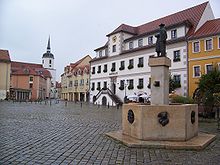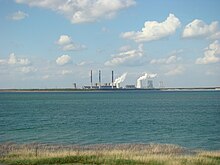
The Upper Lusatian heather and pond landscape includes the northern part of Upper Lusatia, in the extreme northeast of Saxony, at the transition to Lower Lusatia, which belongs to the state of Brandenburg. Many lakes and forests invite you to relax and take long bike tours.
Regions

- The Upper Lusatian heath and pond area (in the narrower sense) extends from the area around Kamenz to the Neisse. The groundwater is very high here; the vegetation is i.a. characterized by sand pines and birches, bushes (juniper, blueberries and cranberries), herbs, grasses and many mushrooms. Due to the abundance of water, numerous fish ponds have been created for centuries, which are connected by ditches. Subareas are the Baruther Heide, the Biehainer Forst, the Große Heide and the Noeser Heide.
- The Königsbrück-Ruhlander Heiden occupy the north-western part of Upper Lusatia, west of the Black Elster near Hoyerswerda. Most of them are covered by forests. They have a sandy bottom and are often very dry. Here, however, is also part of what was formed from flooded open-cast mines Lusatian Lakeland.
- The Muskauer Heide forms the north-easternmost tip of Saxony, between the Schwarzer Elster and the Neisse, in the triangle with Brandenburg and Poland. It forms one of the largest forest areas in Saxony. Above all, dry pine forests grow on the sand and gravel, complemented by blueberries, lingonberries, heather, and in some places mixed pine forests. The eponymous place is well worth seeing Bad Muskau with its park and castle.
places


- Bad Muskau - Fürst-Pückler-Park and Castle (world cultural heritage).
- Niesky - Zinzendorfplatz, local history museum and watch tower.
- White water - Known for its glass production. Glass museum, zoo
- Bernsdorf
- Boxberg, known for what was once the largest lignite power station in the GDR, surrounded by the "lunar landscape" of the opencast mines
- Diehsa - Historical market, bicycle church
- Koenigsbrück - "Gate to West Lusatia" and camellia town on the Via Regia
- Königswartha - Small town on the edge of the biosphere reserve
- Krauschwitz - City south of Weißwasser. Adventure pool, small observatory, motocross track
- Kromlau - Place with rhododendron and azalea park
- Quitzdorf am See - Location at the dam of the same name
- Rothenburg - Location near the Polish border with city museum and city park
- Schwarzkollm - Location of the legendary Black Mill from the Krabat saga
- Uhyst - Location at the Bärwalder See, which is currently in flooding; Wildlife farm
Other goals


- Great heather - Heideregion south of the Muskauer Heide around the place Rietschen.
- Grinder region - Small region around the well-known Sorbian town Runde - seat of the Sorbian cultural center.
- Spreetal is a municipality in the west of the Muskauer Heide (east of Hoyerswerda). It consists of some idyllic villages on the eastern edge of the Lusatian Lake District.
- Parts of the Lusatian Lakeland with flooded opencast mines, including the Bärwalder See, the largest lake in Saxony
- The Upper Lusatian Heath and Pond Landscape Biosphere Reserve offers a unique natural landscape. The land of a thousand ponds with forests, moors and ponds offers hiking and cycling opportunities, sustainable agriculture and fishing with farm shops. The 30,000 hectare reserve has been registered by UNESCO since 1996. It is home to over 3,400 animal species, of which over 800 are on the red list.
background
language
The region largely belongs to the Sorbian settlement area. However, all Sorbs are completely bilingual, so speak German like a second mother tongue, so that there should be no communication problems.
getting there
By train
The City railway Saxony runs every hour from Dresden to Königsbrück, the journey takes just under an hour. Regional express trains from Dresden stop in Hoyerswerda, Schwarzkollm, Lauta, Hosena and Ruhland every two hours (journey time just under 1½ hours).
The S 4 line of the Central Germany S-Bahn also leaves every two hours Leipzig (just under 2½ hours) via Falkenberg (Elster) (a good hour) to Ruhland, Hosena, Lauta, Schwarzkollm and Hoyerswerda.
Out cottbus The East German Railway runs every hour to Runde (25 minutes), Weißwasser (30 minutes), Rietschen, Hähnichen and Horka (55 minutes). Every two hours, the regional express and regional train (combined results in approximately one hourly service) run to Ruhland in 40 minutes.
From direction Gorlitz you can take the East German Railway to Horka (15 minutes), Hähnichen, Rietschen, Weißwasser (35 minutes) and loop. From Görlitz the East German Railway also goes to Niesky (20 minutes) and Hoyerswerda (55 minutes).
Out Berlin Coming, you get to Weißwasser with one change in two hours, with two changes in 2½ hours to Hoyerswerda.
In the western part of the region (around Hoyerswerda, Lauta and Königsbrück), the tariff applies to all buses and regional trains Verkehrsverbunds Oberelbe (VVO), in the eastern part (area Weißwasser, Niesky, Rothenburg) of the des Zweckverband Verkehrsverbund Oberlausitz-Lower Silesia (ZVON).
By bus
The 800 bus runs every hour from Cottbus to Hoyerswerda (journey time 1½ hours), but it is faster by train via Ruhland.
By bicycle
The Oder-Neisse cycle path runs on the eastern edge of the region (through Rothenburg, Bad Muskau). The Spree cycle path leads from Berlin via Lübbenau and Cottbus or in the opposite direction from the source of the Spree near Neugersdorf and Bautzen into the Upper Lusatian Teichland. A stage of the Lower Lusatian mining tour (Cottbus, Forst, Senftenberg) leads through Hoyerswerda. Of Kamenz can be done on the Krabat bike path come to this area.
mobility
The 260 kilometer long Frog bike path forms a large circuit through the entire region and connects the most important natural and cultural monuments (Hoyerswerda – Wittichenau – Neschwitz – Quitzdorf – Niesky – Rothenburg – Bad Muskau – Loop – Hoyerswerda). The Krabat bike path (90 km) primarily connects places with reference to Sorbian literature, especially the eponymous Krabat legend, it leads from Kamenz through Wittichenau, Schwarzkollm and Groß Särchen.
Important regional bus connections are the 106 (Bautzen – Malschwitz – Niesky, hourly, runs through the middle of the Upper Lusatian Heath and Pond Landscape Biosphere Reserve), 159 (Hoyerswerda – Bernsdorf – Königsbrück, every two hours), 182 (Hoyerswerda – Wittichenau – Kamenz , every hour) and 259 (Hoyerswerda – Loop – Weißwasser, every two hours).
A trip with the is worthwhile Muskau Forest Railway, Jahnstrasse 53 (House A), 02943 Weißwasser. Tel.: 49 (0)3576-207472, Fax: 49 (0)3576-207473, Email: [email protected]. . It connects the places Bad Muskau, White water and Kromlau.
Tourist Attractions

- Bad Muskau. Largest English landscape park in continental Europe, is a UNESCO World Heritage Site.
- House of a Thousand Ponds. Exhibition and information center of the UNESCO Biosphere Reserve Upper Lusatian Heath and Pond Landscape in Malschwitz OT Wartha.
- Krabat Mill Schwarzkollm. The Krabat legend is one of the most famous myths of Lusatia and comes in numerous variants; In some versions Krabat is an evil black magician, in others he uses his magical powers for the benefit of the population. In the version that was made known to a larger audience outside of the region by the writers Jurij Brězan and Otfried Preußler as well as several film adaptations of the material, Krabat is initially a beggar boy who gets lost and mysteriously in the forest Black mill comes across, whose mysterious “master” accepts him as an apprentice. He realizes that the master is a black magician. Krabat then learns magical skills himself until he can defeat the master and free the other apprentices. In the mill, the history of the Krabat saga as well as knowledge of the Sorbian language and customs are conveyed in a vivid way (target group are primarily children and young people). The Krabat Festival also takes place here in July every year.
- Nochten boulder park, at the former Nochten opencast mine near Boxberg. 17 hectares of blooming heather bores and dunes with approx. 3000 erratic boulders.
- Knappenrode energy factory, at Hoyerswerda. Saxon Industrial Museum, historic briquette factory.
activities
Experiences for children:
- Kaltwasser children's play park, Am Kulturhaus 6, 02826 Neisseaue / OT Kaltwasser. Tel.: 49 (0)35825-61457, Mobile: 49 (0)173-8430394, Fax: 49 (0)35825-61457. Open: Easter to October: 10: 00-18: 00. - For children up to the age of 12 there are around 40 play areas and pony rides on weekends.
Nature trails: The Upper Lusatian Heath and Pond Landscape Biosphere Reserve offers interested visitors two nature trails for informative hikes through the landscape:
- Nature discovery trail, landscape history
- Nature trail Guttau ponds and Olbasee in the Upper Lusatian Heath and Pond Landscape Biosphere Reserve (8.3 km)
Cycle touring: for example on the Froschradweg (260 km) or Krabat-Radweg (90 km), see above (#Mobility)
Sport and fun:
- There is swimming, sauna and wellness in the Krauschwitz adventure world.
kitchen
- Fish from the Oberlausitz ponds, especially carp
